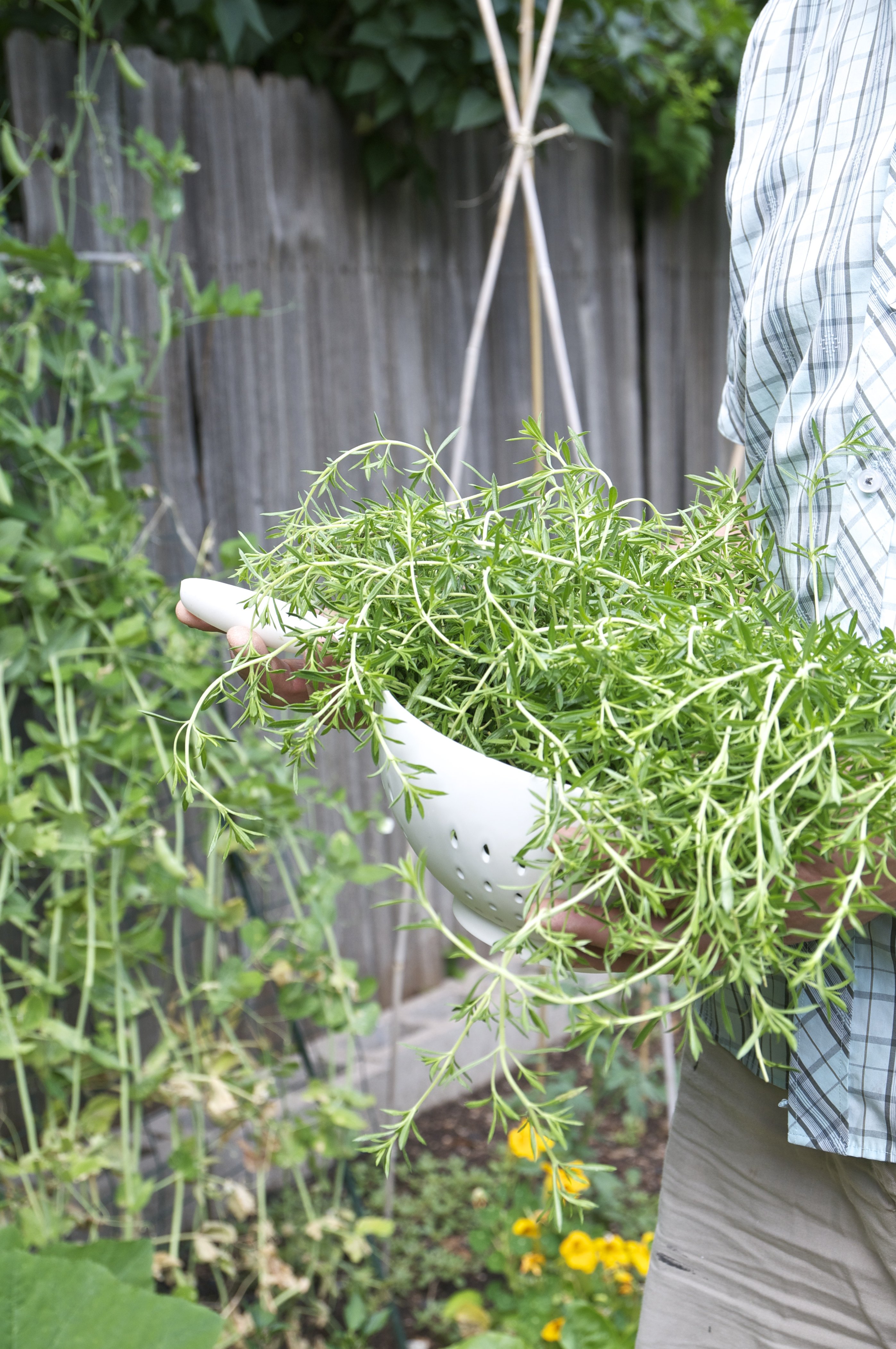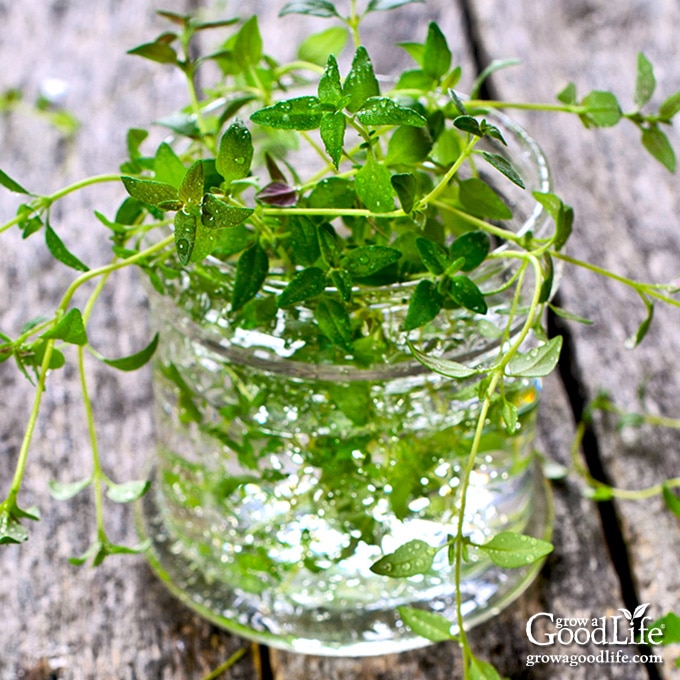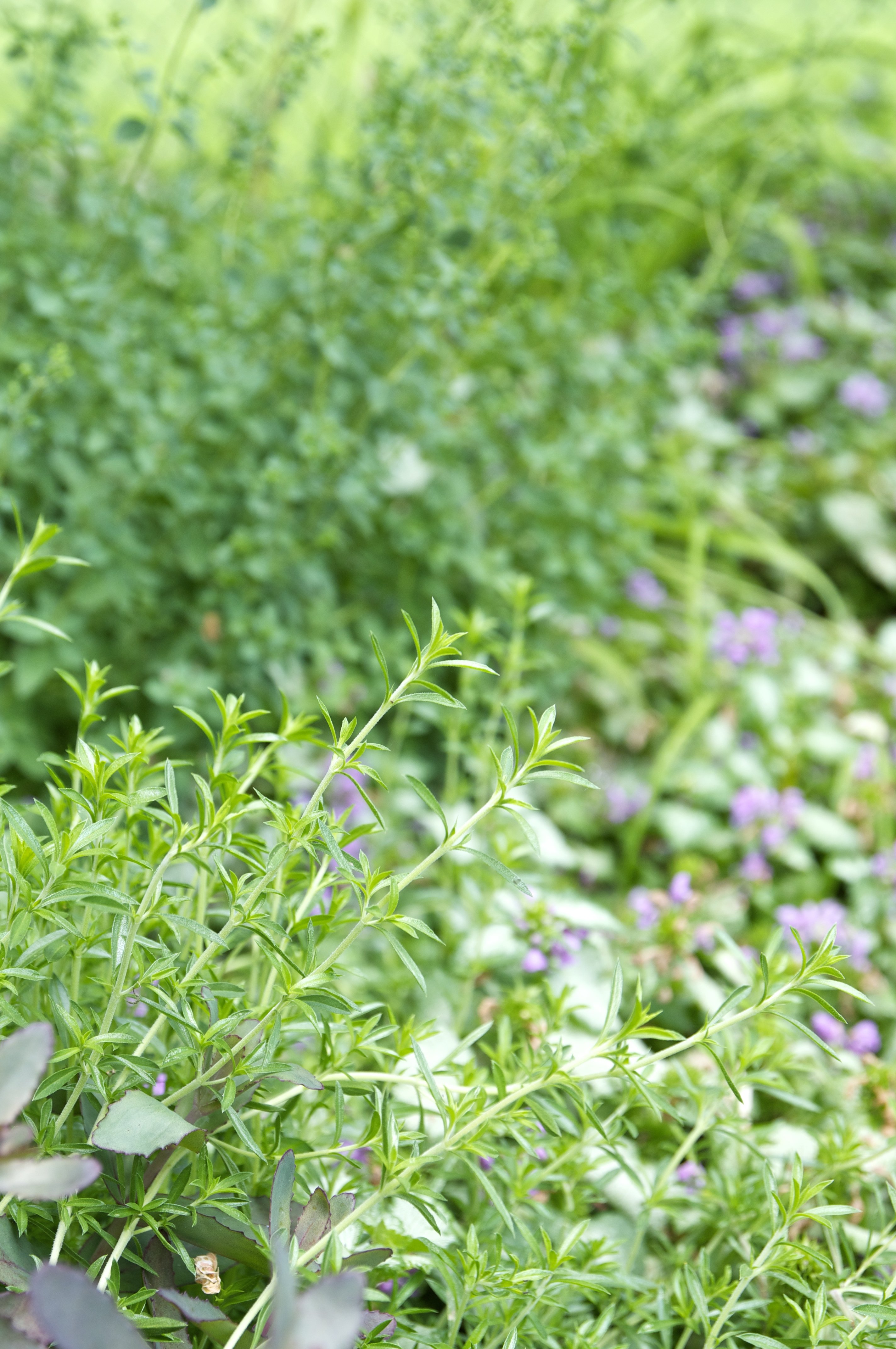Thyme plants droop or wilt due of the excessive moisture in the soil surrounding their roots brought on by overwatering or by soils that drain slowly, which can result in root rot. Root rot is characterized by a drooping appearance and brown or yellowing of the foliage.
While overwatering is the most frequent cause of thyme plant wilting or drooping. Thyme can also droop as a result of transplant shock, small pots and containers that dry out too rapidly, and excessive fertilizer.
It is typical for some thyme kinds, such creeping thyme, to naturally trail along the ground or down the side of pots.
Continue reading to discover the causes of your thyme’s withering and the steps you can take to stop it from drooping so that it grows robust, aromatic, and flavorful.
Table of Contents
Watering Thyme too Frequently
The most frequent cause of thyme plants seeming wilted or drooping, as opposed to inadequate moisture, is excessive watering.
You are watering your thyme plant too frequently if you give it more than once a week.
Herbs like thyme have its roots in the Mediterranean region of Europe, specifically in Spain, Southern France, and Italy.
Since the Mediterranean climate and soil conditions are characterized by full sun, low to medium fertility, and little rainfall, thyme has evolved specifically to grow in these conditions.
The roots of thyme plants are sensitive to overwatering because of their affinity for dryer environments, which encourages root rot and other fungi diseases.
Thyme is recognized as drought tolerant due to its adaptations to the arid Mediterranean region, and overwatering is much more problematic than underwatering.
The following are the most typical signs of an overwatered thyme plant:
- withering or drooping foliage
- becoming brown or yellow in the leaves.
Both of these symptoms are indications of stress rather than a water shortage, which is a common error gardeners make. This is because there is consistently too much moisture around the roots.
The Approach…
The most crucial action to take is to reduce watering thyme plants that are wilting.
Only water thyme when the soil is mostly dry to a depth of two fingers because thyme plants thrive when their soil is allowed to go relatively dry between bouts of watering.
In order to clarify, below is a table that shows how frequently you should water thyme plants in various situations and climates. Of course, watering frequency should vary from climate to climate.
| Climate and Environment | When Should You Water Thyme? |
| Thyme in a pot or container: | Thyme grown in pots or containers should receive a weekly bath. |
| In raised beds, thyme: | Unless there has been a lot of rain, water thyme once a week with a good soak. If there has been a lot of rain, wait until the soil feels dry before watering again. |
| In garden soil, thyme: | Thyme plants frequently get all the moisture they need from their surroundings once they are well-established, so they don’t need any further watering. only if more than two weeks have passed without rain. |
| Warm Climates | During the Spring and Summer, water consistently once per week with a nice soak. |
| Weather Conditions: | Only water when the soil feels dry because thyme is more susceptible to overwatering and drooping in cool climates with high rainfall. If there has been a lot of rain, avoid watering, and if your plants are in pots and it’s hot outside, water them once a week. |
| Winter: | As a result of the wet soils in winter, thyme is more likely to droop. The exception is if the thyme is indoors or covered, in which case water it once every 4-6 weeks. |
Your thyme plant should seem healthy rather than wilting or drooping as long as you control the frequency of watering such that the soil dries out between bouts of watering.
To lower the risk of fungus, always water the plant from the base as opposed to overhead watering on the leaves.
Water deeply rather than lightly since the former just drenches the top few inches of the soil.
Generous watering promotes root growth and establishment, but low watering causes roots to seek water near the soil’s surface, which inhibits healthy root development.
It should be mentioned that in order to keep thyme from drooping owing to water sensitivity, the drainage of your soil is just as crucial as how frequently you water it.
(Read my article on how to save a dying thyme plant for additional details.)
Slow Draining Soils (Amend with Sand)
The soil is mostly stony or sandy in the native Mediterranean range of thyme. Since these soils are so porous, excess moisture may quickly drain away from the roots instead of keeping them constantly damp.
Thyme cannot be grown in soils like clay or in low-lying or bog sections of the garden because they hold too much moisture.
The thyme plant may droop or wilt as a symptom of stress if the potting soil is fully rich compost because it retains too much moisture.
It is crucial to fix the issue since root rot and fungal diseases can develop if the roots are left in wet soil for an extended period of time.
How to fix it
By adding horticultural sand or grit to your soil or potting mix, you can effectively produce thyme plants that do not droop, turn yellow, or brown. This will recreate the sandy soil conditions to which they are suited.
By improving drainage and balancing the nutrient profile, the sand or grit recreates the soil conditions of thyme’s natural environment.
When potting your thyme plants or when preparing the planting area in garden soil, you can achieve this by adding around 30% sand to 70% multipurpose compost.
Do not worry about the accuracy of your measures as long as the sand is blended evenly because too much sand is preferable than not enough.
I advise transplanting or planting your thyme in a container or raised bed if your soil is clay and keeps moisture.
Compared to garden soil, pots offer better drainage characteristics, and it is much simpler to add compost and sand to the soil profile and control the drainage.
Examine the roots before transplanting your thyme that is drooping from slow-draining soil.
- With a pair of pruners, remove the diseased root and encourage healthy development if the roots are dark brown and appear to be rotting.
- After each cut, wipe the pruner blades with a cloth dipped in disinfectant to avoid possibly transferring any fungi from infected roots to otherwise healthy roots.
- Use clean pruners to remove any brown foliage and encourage healthy development.
- The thyme should be replanted in a pot with fresh soil that has been sand-amended for better drainage.
- To help it recover from transplant shock, water the thyme plant. Depending on how bad the root rot was, this could take a few weeks.
The highest chance for recovery for the thyme is provided by taking these actions. However, thyme can perish if the look of drooping is brought on by severe root rot, thus disease prevention with well-draining soils is frequently preferable than cure.
(Read my article Why Thyme Plants Turn Brown if your thyme plants’ leaves have turned brown.)
Pot or Container too Small
Despite the fact that thyme is a drought-tolerant plant that does well in arid environments, it’s likely that your thyme plant is wilting because of:
- Being too little for the pot.
- Pot constructed of thin metal or plastic.
Thyme plants thrive in pots because of the favorable drainage conditions, but if the pot is too tiny, there is less room for soil and consequently less moisture.
Smaller pots heat up in direct sunlight far more quickly than larger ones, which accelerates soil evaporation.
Because of this, the soil in the pot may dry out before the roots have a chance to absorb any hydration.
The thyme plant may not receive enough water as a result of this dry soil, and as a result, it may wilt or droop as a symptom of stress.
The kind of pot your thyme is grown in is another issue.
Thyme might droop if it is grown in a plastic or metal container because the soil dries out too rapidly.
In contrast to the porous texture that thyme plants require, plastic and metal effectively transport heat, which raises the soil’s temperature and causes it to dry out too soon to the point where it can bake hard.
The Approach…
Small pots can cause the soil to get dry, but the solution is not to water the plant more regularly because this might lead to overwatering issues (promoting the conditions for root rot).
Instead, grow your thyme in a bigger pot since it will have more soil, which will promote stronger root growth, making the thyme more hardy and giving it easier access to nutrients and moisture when it needs it.
For a healthy potted thyme plant that does not run out of water too soon on the hottest days of the year so that the plant does not droop or wilt, plant thyme in a pot that is at least 12 inches wide. This will ensure the best balance of soil capacity and root development.
If you want to cultivate thyme or any other Mediterranean plant, use a pot or container made of ceramic, terracotta, or clay.
These materials allow for greater root respiration and do not heat up as soon as metal pots, preventing the soil from drying out before the thyme’s roots can draw on it to prevent drooping. These materials are permeable, allowing for better root respiration.
Transplant Shock
Thyme may be experiencing transplant shock if it starts to droop or wilt right after being planted.
Thyme purchased from a garden center or nursery is frequently grown in greenhouse circumstances with exact temperature control, a schedule for sunlight and watering, a particular level of humidity (low humidity is preferable), and roots that are used to the soil around them.
There is frequently a mismatch between the conditions in the greenhouse where the thyme plant was grown and the conditions in your garden when you buy it and plant it.
The thyme may often react to the change in environment by wilting or drooping.
The Approach…
If your thyme started to droop a little after planting, don’t be alarmed; this is very usual.
Providing your thyme with the ideal growing circumstances will help it deal with and recover from transplant shock:
- Thyme should be planted in the right pot.
- Verify that the soil profile has been modified to reflect the characteristics of Mediterranean soil.
- After planting, immediately wet the thyme (then water thyme once per week for the first 4 weeks).
- Find thyme in a sunny area (at least 6 hours).
Any drooping or wilting is likely to be transitory while the plant tries to establish in the new soil and adapt to the varied conditions because thyme is a resilient plant that can handle transplanting and varying environments.
Thyme should recover from its drooping appearance after a few days and thrive as long as it is properly watered, in a large pot with a sandy soil mix, and in full sun.
Too Much Fertilizer
In these soil conditions, the smell and flavor of the leaves are at their peak, and an excess of nitrogen fertilizer can affect the flavor and encourage the growth of foliage at the expense of blossoms.
The use of fertilizer is in opposition to the environment to which thyme has adapted because it flourishes in sandy soils with little retention of moisture or nutrients.
A surplus of nitrogen from fertilizer causes:
- lanky, sagging vegetation
- The taste and perfume of the leaves are less strong.
- less flowers
- Yellowing leaves are possible.
The answer is…
With a pair of pruners, remove any leggy growth that is causing the thyme to droop and stop applying fertilizer.
Even though it can take a few weeks, this should allow your thyme a chance to recover.
Making ensuring your thyme is planted in the appropriate soil is a smart idea. Approximately 30% sand or grit and 70% compost should be added to the soil to promote drainage and achieve the ideal nutrient balance.
Grit and sand are inorganic substances that help to strengthen the soil’s structure while without adding many nutrients to the ground. This contributes to the low to medium soil conditions that all Mediterranean herbs, including thyme, prefer.
(Read my post on why thyme becomes yellow for further causes and treatments for yellow thyme plants.)
Trailing Varieties of Thyme
It should be noted that some thyme species naturally trail over the edge of pots or raised beds, such as creeping thyme, or “Thymus praecox.” This is a characteristic of the cultivar rather than the thyme plant itself drooping as a result of any environmental issues.
As long as it is in full sun, creeping thyme is content to trail over the ground or over the side of a container.
There are numerous types of thyme, including common thyme (Thymus vulgaris), that should not droop as this is typically caused by overwatering.
Key Takeaways:
- Thyme plants frequently droop as an indication of stress as a result of over watering or soils with poor drainage. Thyme plants can withstand dry soil conditions, but if there is too much moisture around the roots, root rot can cause the plants to droop and turn yellow or brown.
- Reduce watering to once a week and add sand or grit to the soil to encourage drainage.
- The soil can dry out fast in small pots and containers and pots made of metal or thin plastic, which makes thyme droop or wilt. To keep the soil cool and slow down soil drying, plant thyme in a pot that is at least 12 inches across and preferably made of terracotta, ceramic, or clay.
- Thyme may momentarily droop due to transplant shock. After planting, give the thyme a good soak, and place it in broad sunlight. In a few days, the thyme should recover.
- Thyme requires low to medium fertility soil and needs no additional fertilizer as it is a low maintenance plant. Thyme that receives an excessive amount of nitrogen droops, becomes lanky, and loses flavor and scent.
- Some thyme cultivars (like creeping thyme) spontaneously droop over the sides of containers or along the ground.
FAQ
Do thyme need lots of water?
Thyme. Thyme is a herb that requires very little water to grow. This herb just has to be watered every 10 to 15 days. Thyme’s hardiness makes it another plant that may flourish during the colder months.
Why is my thyme turning brown and dry?
Thyme plants turn brown as a result of a fungus that is spread by too much moisture around the roots. Thyme is a Mediterranean herb that enjoys conditions that are relatively dry. Overwatering and poorly draining soils encourage the growth of the fungi that cause the browning of thyme plants.
How do you know when to water thyme?
During the summer, water thyme plants to a depth of 1 inch every 10 to 15 days. Early in the fall, a few weeks before the first rain, stop watering. Only if rainfall is extremely sparse and dry spells linger longer than two to three weeks should you use water throughout the winter. In that scenario, water for 10 to 15 days at a rate of 1 inch.
Does thyme like wet or dry soil?
It requires a well-drained, preferably alkaline soil and is moderately tolerant to drought. It may thrive in relatively rocky, even poor soil. Thyme is ideal for growing in containers of John Innes No 2 compost because it won’t perish in excessively moist soil and will do so if your soil is heavy, poorly draining clay.
Can you overwater thyme?
Thyme plants droop or wilt due of the excessive moisture in the soil surrounding their roots brought on by overwatering or by soils that drain slowly, which can result in root rot. Root rot is characterized by a drooping appearance and brown or yellowing of the foliage. While overwatering is the most frequent cause of thyme plant wilting or drooping.



